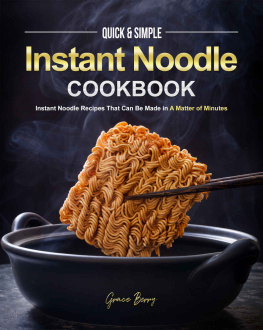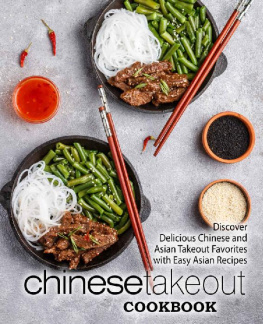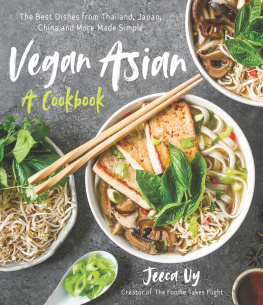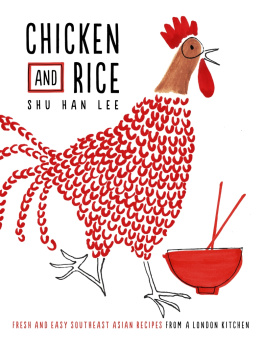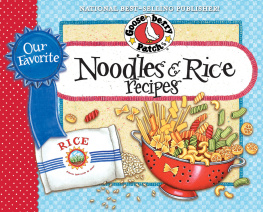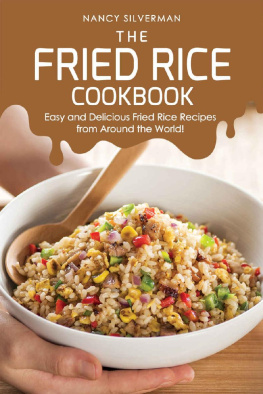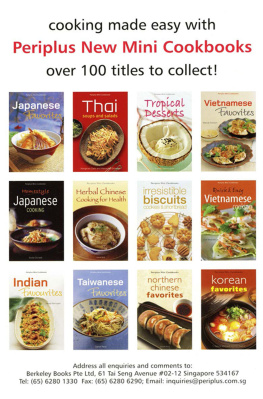
To my daughter, Colette Trang McDonough:
You have reconnected me to the simple pleasures of noodles.
This book would not have been possible without the encouragement and support of my husband, Michael McDonough. After many years, he remains my greatest fan, never too tired to lend a helping hand, or if too tired, never complaining about it. And after his too-numerous-to-count noodle tastings, he always managed a smile and enthusiasm for more. Thank you, darling.
Recipe tastings would not have been possible without my dedicated assistant and recipe tester Graciel Caces, who always came eager to test and learn. Thank you for being so enthusiastic and gracious.
I am ever so grateful to my literary agent, Angela Miller, for continuing to support my work; to Bill LeBlond at Chronicle for encouraging me to write and turn the complex and vast subject of Asian noodles into the simple, accessible recipes listed here; to Amy Treadwell for being so diligent; and to Deborah Kops for her excellent copyediting. I thank you all for keeping me focused.
To designer Patrick Barber, food photographer Maura McEvoy, food stylist Frank Mentesana, and prop stylist Christine Rudolph, for translating the recipes into beautiful pages, I also say thank you. You have added texture, color, and shape to my words. Thank you for having the vision.
To Beth Shepard, for engaging me in multiple platforms to promote what I love. You are remarkable. Thank you for your clarity and know-how.
To Maite Goff and Lisa Coker at Panos brands, for providing me with the all-natural line of KA-ME Asian noodles and condiments in time for testing the recipes. Your product made it so easy to re-create authentic, classic, and contemporary Asian noodle meals. Thank you for participating so generously.
To my friends and family who continue to be supportive and understanding when I dont show up for events or gatherings. My heart always says yes, the scheduling pressures often dictate differently. Thank you for yesterday, today, and tomorrow. For this will likely not be the last time I say yes, maybe, and no simultaneously.
And with that, I raise a glass to you all!
CT
Noodle dishes are eaten as full meals, light meals, and snacks throughout Asia at all hours of the day and night, serving as a kind of sophisticated fast food. My brothers and I grew up eating these noodle dishes in family homes in France and Southeast Asia. When traveling for research, I have enjoyed freshly made mee krob (sweet and crispy fried rice vermicelli) and .
Almost everyone has had a plate of wheat noodlebased chow mein. At restaurants, you and your family may have also experienced more sophisticated dishes, such as Chinese cold sesame noodles; wontons in broth; stir-fried egg noodles with beef and broccoli; the Vietnamese rice noodle soup known as pho; stir-fried broad rice noodles with beef, scallion, and bean sprouts; Korean stir-fried cellophane noodles, known as chap chae; or Japanese soba. It must be noted that pad Thaithe stir-fried Thai noodle dish made with rice noodles, eggs, fish sauce, tamarind, bean sprouts, peanuts, and a variety of proteinsranks among Americans favorite international dishes. In fact, McDonalds was reportedly considering adding Thai dishes to its U.S. menus in 2006. That same year, the New York Times suggested pad Thai as an appropriate snack to be made by moms and kids (see Generation Pad Thai by Jennifer Steinhauer in the New York Times, January 15, 2006).
In Noodles Every Day: Delicious Asian Recipes from Ramen to Rice Sticks, I combine family favorites that I have enjoyed from the time I was a child, familiar restaurant dishes, and interpretations of dishes that I have learned while traveling as an adult in China, Japan, Korea, the Philippines, Indonesia, Vietnam, Cambodia, and Thailand. All of these have been adapted for the contemporary Western kitchen. Noodles form the basis for innumerable Asian dishes, and even a passing acquaintance with a few recipes will open a world of new culinary experiences for most cooks.
Here I explore the idea that these small Asian snack dishes can be the foundations for quick, healthful, and wondrously varied meals, which can be prepared by any home cook. Most include only a few ingredients, go from package and cutting board to skillet and table in about 30 minutes or less, and require no special skills or foreknowledge of Asian cooking to prepare. They can be enjoyed by dyed-in-the-wool meat eaters, vegetarians of all stripes, and serious vegansdepending on the recipe selected and how the ingredients are parsed out. Almost everything you need to succeed in creating great recipes and bold flavors can be found in the international foods aisle of your local supermarket. And the recipes in this book will allow you to extend your range once you master the basics. In essence, if you can make spaghetti, you can cook these dishes.
My hope, then, is to wrestle the extraordinary diversity of Asian noodles into a few categories, and to proceed with a sense of adventure and invention. Broadly speaking, you can group Asian noodles into dry and fresh types, and break them down by main ingredient from there. Surprisingly, perhaps, you wont need any extensive understanding of country of origin because most of these noodles are used all throughout Asia. When it makes sense, I give the name of the Italian pasta that is roughly equivalent as a sort of shorthand. When an item is unusual or especially suited to a dish, I do identify it as such. And I give the traditional names of specific dishes and note their roots when appropriate.
A balance of ingredient types, with an eye toward healthy eating, is discernable in all the recipes here. They are relatively low in calories without sacrificing flavor. Among the heartier dishes, there are always enough vegetables to balance the protein, and enough carbohydrates to provide quick energy without dominating the dish. Sauces are conceived to complement the basic noodlemore like the Northern Italian notion of staining the pasta with sauce than the Southern Italian tradition of a thick tomato-and-meat ragu.
SOME NOODLE HISTORY (BUT NOT TOO MUCH)
While this book is in no way intended as a dissertation on Asian noodles, the history of noodles is useful as a backstory when cooking, and I find that it makes for interesting conversation at the table. I should note that I generally prefer to steer clear of the origin of noodles question, not because it isnt fun (it is), but because it can become a bit of a quagmire in professional circles if it isnt handled deftly. Food history is serious stuff and archeology is often involved. Academic reputations can rise and fall based on a page in a cookbook or an ingredient discovered out of context.
On an informal and nonprofessional level, however, I like to give a nod to my Chinese fathers long-standing and often passionately expressed assertion that noodles started among the Chinese, and not among the other two contendersthe Italians and Arabs. At least one version of modern conventional wisdom holds that Chinese noodles were invented elsewhere, derived from similar foods developed in southwest and central Asia about two thousand years ago. The great Arab civilizations, the theory goes, first invented and then shared noodle-making techniques with the Romans. The Romans, it continues, popularized them and brought them to greater Italy, and eventually to China via Marco Polo and other trade-route adventurers. Other variations on this theme exist, but you get the idea: in essence, the Chinese received the noodle; they didnt invent it. Nonsense! my father would respond in annoyance upon hearing this argument.
Next page


